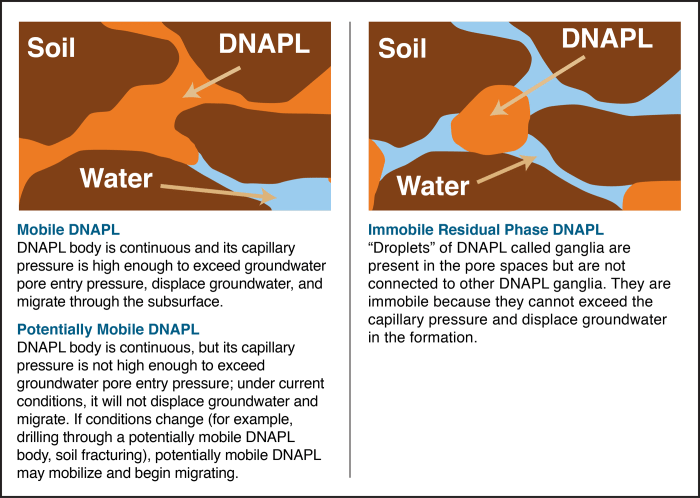Dense nonaqueous phase liquids (DNAPL) are a group of halogenated semi-volatiles, non-halogenated semi-volatiles, and halogenated volatiles with a greater density than water. These contaminants are found at hazardous waste sites where chlorinated solvents, wood preserving wastes, coal tars, and pesticides have been used.
DNAPL are present in immiscible hydrocarbon phase and often are difficult to detect.
All DNAPL contamination must be reported to the EPA in NSW under the Contaminated Land Act 1997 and various other states also have this requirement. The EPA will then advise of your next reporting steps depending on the size of the DNAPL release.
DNAPL risk assessment can be difficult as the DNAPL distribution is determined by the differences in soil or rock, which also affects most measuring instruments. To fully and correctly assess a DNAPL contaminated site the hydrogeology of the site must be known and understood.
Common DNAPL compounds include materials that have been or are still widely used in industrial and commercial processes, such as the following:
- chlorinated solvents
- coal tar
- creosote
- heavy petroleum—for example, No. 6 fuel oil products
- polychlorinated biphenyls (PCBs)
- pesticides
To detect DNAPL, groundwater well screens must include screening to the base of the porous aquifer, to detect DNAPL that, being denser than water, has migrated downward due to gravity until it reaches a geological barrier (known as an aquitard or aquiclude). The presence of DNAPL presents a risk, as it a source of ongoing groundwater contaminant concentrations as it weathers and the contaminants within the DNAPL become dissolved phase and migrate with groundwater movement. If groundwater is not properly investigated and DNAPL no properly assessed, remediation can be wasted by focussing on dissolved phase concentrations, without delineating and focussing on removal or transformation of DNAPL.
Field techniques such as the use of FLUTe liners and interface probes, core analysis, or newer probing technologies are required to properly investigate the presence of DNAPL. As the liner everts down the borehole, the NAPL cover is pressed against the borehole wall by the interior liner pressure. As the NAPL FLUTe is hydrophobic, it quickly wicks any NAPL contacted in the fractures or pore space into the cover.
There are various famous dry cleaning sites with chlorinated hydrocarbon sites that have resulted in millions of dollars in remediation and wasted spending on not properly understanding or delineating DNAPL, the geological conditions or the chemical transformation of resultant contaminants.
Because of the complexity of remediating and assessing DNAPL sites such as dry cleaners, the risk associated with property transactions on or near DNAPL risk sites can be greatly affected.
If you have a property with DNAPL contamination or has the potential to be located near or on a dry cleaner site, iEnvi have a range of cost-effective and successful strategies to assess risk, and if required remediate contamination.
Perchloroethylene (PERC) is the main waste involved in dry cleaners that requires special management. NSW EPA has created a guidance note on the management of PERC waste. Finding a good management system to manage PERC waste is essential, as even after you sell a property affected you will still be liable under polluter pays principles (even 20 years in the future).
Additionally, NSW EPA applies certain fines for improper disposal of PERC waste:
- Up to $5,000,000 or a seven-year jail sentence if waste is illegally dumped and harms the environment. Up to $1,000,000 for transporting waste (or causing waste to be transported) to a place that cannot lawfully receive waste.
- Up to $250,000 for supplying false or misleading information about waste.
If released to ground through leaks, spills or broken drainage, the PERC waste can lead to DNAPL contamination, and may lead to vapour inhalation risk caused by carcinogenic compounds.
For advice on DNAPL contamination, contact us on [email protected] or 13000 43684 (13000 iEnvi).


